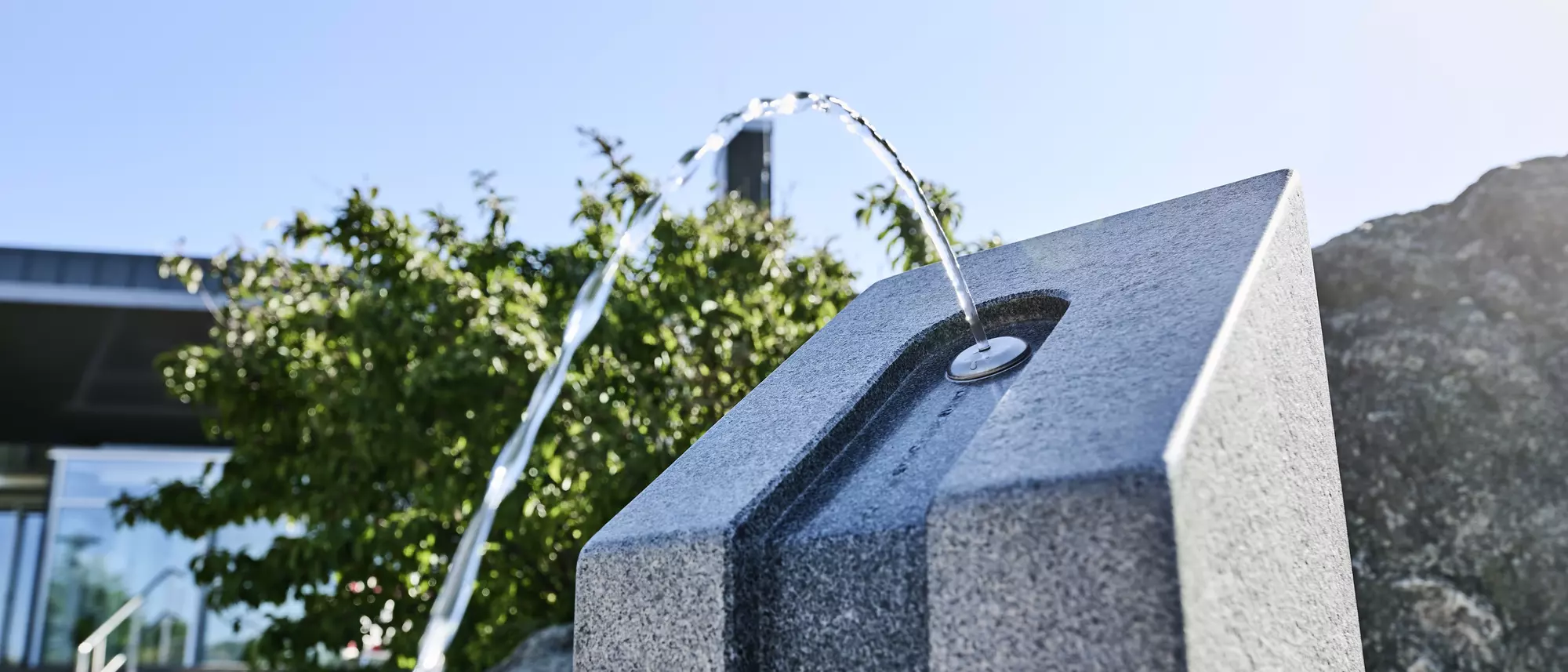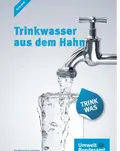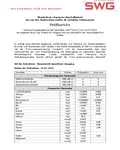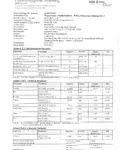SWG water supply area
We take on different tasks depending on the municipality:
- In Giessen, both the water supply and the water operations management are carried out by Stadtwerke Giessen.
- Buseck and Grünberg receive water supplies, but SWG is not responsible for operations management.
- By contrast, in the municipalities of Wettenberg, Heuchelheim, Allendorf (Lumda), Rabenau and the Dieberg Group, only water operations management is carried out, but water is supplied either independently or by the Mittelhessische Wasserbetriebe special-purpose association.
In the supply area of Stadtwerke Gießen, the connection rate is 100%.
Queckborn waterworks
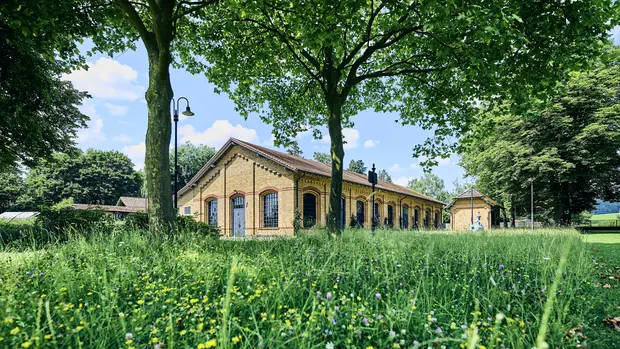
For over 130 years, the best water has been gushing out of the ten wells of the Queckborn waterworks for the city of Giessen. The wells capture a very productive extraction horizon in the basalts of the Vogelsberg, which, for morphological reasons, comes close to the surface in the Äschersbach valley and used to emerge in strong springs. The extracted groundwater flows into the extraction area over a wide area from the north and north-east. Due to the filtering effect of the basalt layers, the raw water is of very good quality. At the waterworks, it is only disinfected by a UV system as a precautionary measure and then deacidified via Riesler.
In order to secure the water supply to the SWG areas at all times, Stadtwerke Gießen also obtains drinking water from the Mittelhessen special-purpose association, whereby the annual share is around 30 per cent.
Discover drinking water treatment at the Queckborn waterworks
Get to know the path of our drinking water - from the source to your home. During an exciting guided tour of the Queckborn waterworks, we offer you exclusive insights into the processes of drinking water extraction and treatment.
For school classes and adult groups: Whether young explorers or interested adults, our guided tour is suitable for school classes from primary school upwards as well as for adult groups.
Duration: The tour lasts approx. 2 hours. Allow extra time for travelling to and from the tour.
Number of participants: We welcome groups of at least 20 to a maximum of 35 people.
Queckborn waterworks of Stadtwerke Gießen AG
Schnepfenhain 36
35305 Grünberg
Tips for handling water
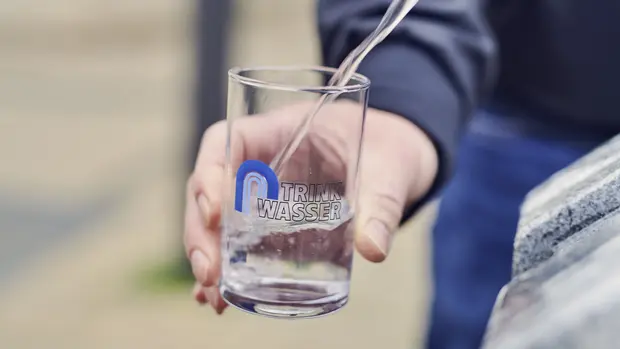
Drinking water is our most important foodstuff and a valuable resource. We therefore ask you to use it responsibly and sparingly. Here are some simple measures that can help:
- Limit garden watering to the bare minimum
- Refrain from watering lawns
- Reduce car washing
- Limit the filling and refilling of swimming pools
- Refrain from cleaning house forecourts with water
- Avoid full baths
- Do not carry out fire drills using drinking water
Dealing with stagnant water
In addition to the tips for the responsible use of drinking water, we would like to draw your attention to the Federal Environment Agency's advice on avoiding damage to human health caused by stagnant drinking water.
Stagnant water is water that has been standing in the pipes for four hours or longer. This can be avoided or circumvented with the following actions:
- Draw off drinking water regularly to avoid long dwell times of water in the installation.
- Do not use stagnant water that has been in the pipes for more than four hours for drinking or preparing food. Drain stagnant water. You can recognise fresh water by its cooler temperature.
- Do not use hot water from the tap for drinking or preparing food. Although it is classed as drinking water, it naturally has longer contact times with the installation, particularly in the case of a centralised hot water supply. In addition, an increased temperature generally promotes the transfer of undesirable substances into the water.
- When not in use (guest bathroom, holiday flat, longer absences), ensure that the pipes are flushed regularly or disconnected from the rest of the pipe network.
- Three days or more: Open the taps to ensure that the system or system components are completely replaced with drinking water.
- More than four weeks: Shut off the affected pipes before absence; flush the pipes when restarting.
- Federal Environment Agency brochure
Water hardness
Water hardness affects the flavour and quality of our water and has an impact on household appliances and fittings. The degree of hardness is determined by the lime contained in the water: the more lime, the "harder" the water. Lime refers to the minerals calcium and magnesium that are dissolved in the water. Hard water has advantages and disadvantages: It contains more minerals than soft water, but requires a higher dosage of detergent, for example, and leads to the calcification of household appliances in the long term.
Categorisation into three hardness ranges
The total water hardness is given as the sum of the alkaline earths calcium and magnesium dissolved in the water in millimoles per litre (mmol/l). Since 1 February 2007, three hardness ranges have been defined for drinking water: from soft (less than 1.5 millimoles of alkaline earths per litre) to medium (1.5 to 2.5 millimoles per litre) to hard (more than 2.5 millimoles per litre).
Giessen water
Our water is in the soft to medium hardness range:
- The water from Queckborn has a medium hardness, but is just on the edge of soft.
- The water from the Zweckverband Mittelhessische Wasserwerke, on the other hand, is soft.
- For some water customers in Giessen, a mixture of both waters flows from the tap.
We generally recommend dosing detergent for the soft water hardness range.
Water hardness in our neighbourhoods
| Area | Water hardness |
| Giessen - city centre | medium* |
| Giessen - Petersweiher settlement | medium |
| Giessen - Allendorf district | soft |
| Giessen - Kleinlinden district | soft** |
| Giessen - Lützellinden district | soft |
| Giessen - Rödgen district | soft |
| Giessen - Wieseck district | medium |
| Giessen - Uni - Network | medium |
* The following streets have the following water hardness: soft
Altenbergweg, Alter Krofdorfer Weg, Anne-Frank-Straße, Carlo-Mierendorff-Straße, Dietrich-Bonhoeffer-Straße, Dünsbergstraße, Europastraße, Frankfurter Straße (from no. 201 Kleinlinden district), Friedrich-Naumann-Straße, Gleiberger Weg, Grüner Weg, Hardtallee, Herderweg, Hochwarte, Holzweg, Hugo-von-Ritgen-Straße, Karl-Sack-Straße, Kerkrader Straße, Königgrätzer Straße, Krofdorfer Straße, Kropbacher Weg, Läufertsröder Weg, Launsbacher Weg, Leimenkauter Weg, Mohrunger Weg, Netanyastraße, Oberer Gleiberger Weg, Oberer Hardthof, Pater-Delp-Straße, Paul-Schneider-Straße, Paul-Zipp-Straße, Richard-Schirrmann-Weg, Salzböder Weg, Schießgärten, Schützenstraße (from no. 9), Schwalbachacker, Unterer Hardthof, Unterm Hardtwäldchen, Versailler Straße, Vetzberger Weg, Weilburger Grenze, Wettenberger Weg, Wilhelm-Leuschner-Straße, Winchester Straße, Zur Großen Bleiche
** The street "Bachweg" has the water hardness: medium
Mandatory publications
Drinking water analyses
The drinking water is sampled quarterly at different points in the network. A comprehensive sample is taken once a year, the current results of which can be viewed in the physico-chemical quality test report.
In agreement with the Giessen health authority, the water obtained from the Queckborn wells is not analysed for radioactive substances, as these were regularly well below the limit value when the samples were tested and are therefore not of concern.
